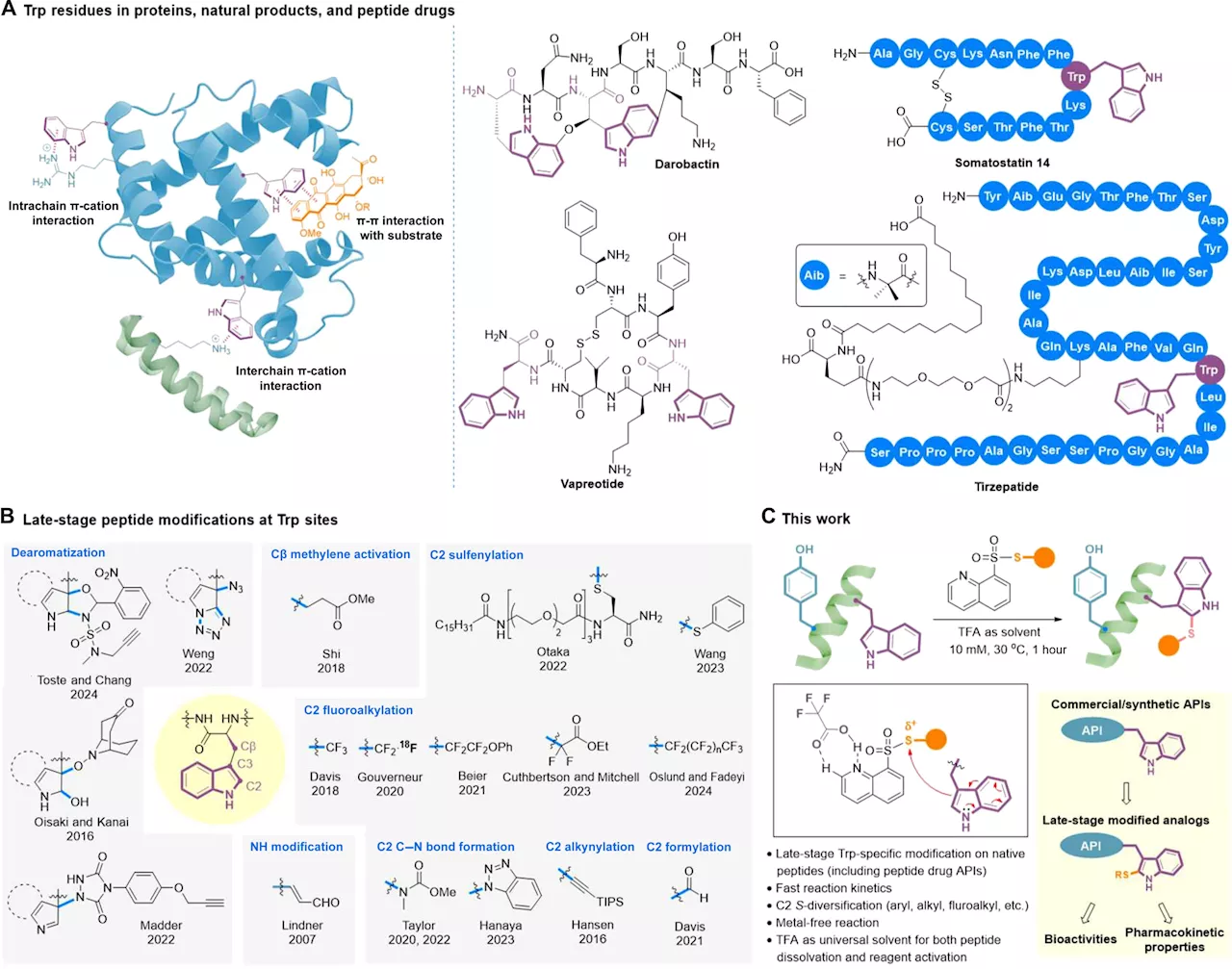Chemists developed a way to synthesize complex molecules called oligocyclotryptamines, originally found in plants, which could hold potential as antibiotics, analgesics, or anticancer drugs.
MIT chemists have developed a new way to synthesize complex molecules that were originally isolated from plants and could hold potential as antibiotics, analgesics, or cancer drugs.
In addition to allowing scientists to synthesize oligocyclotryptamines found in plants, this approach could also be used to generate new variants that may have even better medicinal properties, or molecular probes that can help to reveal their mechanism of action.Oligocyclotryptamines belong to a class of molecules called alkaloids -- nitrogen-containing organic compounds produced mainly by plants.
When the researchers shine certain wavelengths of light on the substrate containing the two fragments linked via the two nitrogen atoms, it causes the two atoms of nitrogen to break away as nitrogen gas, leaving behind two very reactive carbon radicals in close proximity that join together almost immediately. This type of bond formation has also allowed the researchers to control the molecules' stereochemistry.
"The reason why we're excited about this is that this single solution allowed us to go after multiple targets," Movassaghi says."That same route provides us a solution to multiple members of the natural product family because by extending the iteration one more cycle, your solution is now applied to a new natural product."Using this approach, the researchers were able to create molecules with six or seven cyclotryptamine rings, which has never been done before.
They should also be able to create novel compounds by switching in slightly different cyclotryptamine subunits, Movassaghi says.
Diseases And Conditions Multiple Sclerosis Research Nature Endangered Plants Organic Organic Chemistry Chemistry Graphene
United States Latest News, United States Headlines
Similar News:You can also read news stories similar to this one that we have collected from other news sources.
 Chemists synthesize plant-derived molecules that hold potential as pharmaceuticalsMIT chemists have developed a new way to synthesize complex molecules that were originally isolated from plants and could hold potential as antibiotics, analgesics, or cancer drugs.
Chemists synthesize plant-derived molecules that hold potential as pharmaceuticalsMIT chemists have developed a new way to synthesize complex molecules that were originally isolated from plants and could hold potential as antibiotics, analgesics, or cancer drugs.
Read more »
 Chemists develop new sustainable reaction for creating unique molecular building blocksPolymers can be thought of like trains: Just as a train is composed of multiple cars, polymers are made up of multiple monomers, and the couplings between the train cars are similar to the chemical bonds that link monomers together.
Chemists develop new sustainable reaction for creating unique molecular building blocksPolymers can be thought of like trains: Just as a train is composed of multiple cars, polymers are made up of multiple monomers, and the couplings between the train cars are similar to the chemical bonds that link monomers together.
Read more »
 Chemists develop new sustainable reaction for creating unique molecular building blocksPolymers can be thought of like trains: Just as a train is composed of multiple cars, polymers are made up of multiple monomers, and the couplings between the train cars are similar to the chemical bonds that link monomers together.
Chemists develop new sustainable reaction for creating unique molecular building blocksPolymers can be thought of like trains: Just as a train is composed of multiple cars, polymers are made up of multiple monomers, and the couplings between the train cars are similar to the chemical bonds that link monomers together.
Read more »
 Chemists develop test to track crucial edits to RNAA research team's new technique could help scientists worldwide identify novel targets for cancer therapies.
Chemists develop test to track crucial edits to RNAA research team's new technique could help scientists worldwide identify novel targets for cancer therapies.
Read more »
 Chemists develop clickable tryptophan modification strategy for late-stage diversification of native peptidesPeptides are gradually emerging as middle-sized therapeutic agents for addressing unmet medical needs. Compared to small-molecule drugs, peptides can target complex biological processes more precisely while being generally less complex and more cost-effective than large biological drugs such as antibodies.
Chemists develop clickable tryptophan modification strategy for late-stage diversification of native peptidesPeptides are gradually emerging as middle-sized therapeutic agents for addressing unmet medical needs. Compared to small-molecule drugs, peptides can target complex biological processes more precisely while being generally less complex and more cost-effective than large biological drugs such as antibodies.
Read more »
 Chemists reveal how Rembrandt combined special pigments for golden details of 'The Night Watch'Chemists at the Rijksmuseum and the University of Amsterdam (UvA) have for the first time established how Rembrandt applied special arsenic sulfide pigments to create a 'golden' paint.
Chemists reveal how Rembrandt combined special pigments for golden details of 'The Night Watch'Chemists at the Rijksmuseum and the University of Amsterdam (UvA) have for the first time established how Rembrandt applied special arsenic sulfide pigments to create a 'golden' paint.
Read more »
